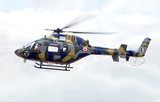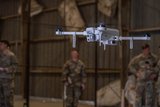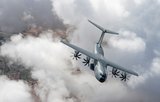Slovakia approved for US$600 million AH-1Z helicopter order
Slovakia currently has no attack helicopters so the arrival AH-1Zs would be a major capability boost. (Photo: USMC)
The US State Department has approved the sale of 12 Bell Textron AH-1Z Viper attack helicopters to Slovakia under a US$600 million deal which includes missiles, guns and launchers.
Slovakia will join the neighbouring Czech Republic if the order goes ahead along with Pakistan, the US and Bahrain. Nigeria has also been cleared to purchase the platform and a contract placed but deliveries have yet to begin.
As well as the helicopters, the deal includes 26 T-700 GE 401C engines (24 installed, 2 spares), 1,680 WGU-59/B Advanced Precision Kill Weapon Systems (APKWS) and 14 Honeywell embedded global positioning systems/inertial navigation systems (12 installed, 2 spares).
Other systems include Helmet Mounted Display System/Optimized TopOwl, Target Sight Systems and containers, ANVIS-9 night-vision cueing displays, AN/ARC-210 Generation 6 receiver-transmitter 2036 radio equipment and AN/APX-123A identification friend or foe (IFF) Mode 5 systems.
Kinetic weapons approved under the deal include WTU-1B warheads, M-197 20mm armament pod gun assemblies, 20 mm PGU-27A/B target practice rounds and 20 mm PGU-28A/B semi armour piercing high explosive incendiary rounds.
Protection systems include AN/ALE-47 chaff and flare countermeasures systems, MJU-32A/B and MJU-49B decoy flares, SMB875B/ALE flare simulators, AN/AAR-47 missile warning system and AN/APR-39C radar warning receiver and conversion kits.
The AH-1Z Viper is an upgrade to AH-1W and replaces the existing cockpit and drive system with an integrated digital/glass cockpit, four-bladed, all-composite, hingeless, bearingless rotor system, drivetrain, engine, transmission, hydraulics, electrical systems and tail boom.
Related Equipment in Defence Insight
More from Air Warfare
-
![Dubai Airshow 2025: GA-ASI’s MQ-9B racks up new milestones with AEW demo planned]()
Dubai Airshow 2025: GA-ASI’s MQ-9B racks up new milestones with AEW demo planned
The company announced its demonstration timeline while confirming the MQ-9B had completed the platform’s third lifetime test.
-
![Dubai Airshow 2025: Edge Group eyes international market expansion, unveils new UAVs]()
Dubai Airshow 2025: Edge Group eyes international market expansion, unveils new UAVs
The UAV portfolio expansion comes in the wake of the Edge-Anduril joint venture announced ahead of the airshow.
-
![European firms express interest in filling NATO airborne early warning replacement needs]()
European firms express interest in filling NATO airborne early warning replacement needs
The comments from both Saab and Airbus on their potential to fulfil the airborne early warning and control requirement come after NATO countries shelved plans to procure six E-7 Wedgetail AEW&C aircraft.
-
![Dubai Airshow 2025: Lockheed’s AGM-158 XR flight tests planned for 2026]()
Dubai Airshow 2025: Lockheed’s AGM-158 XR flight tests planned for 2026
The AGM-158 XR, which started as a Lockheed Martin internal investment, was first unveiled in September 2024.
-
![Dubai Airshow 2025: Airbus reveals progress on drone mothership plans for A400M]()
Dubai Airshow 2025: Airbus reveals progress on drone mothership plans for A400M
Airbus is working to expand the mission capabilities of its A400M aircraft, including a 40t payload increase, to boost Europe’s defence capabilities.






















